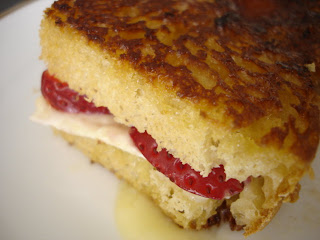














Amazing. Where had this been, why hadn't I had this before?










At this point, the curds were surely ready to be cut into cubes, destined for an olive oil soak; I'm trying to recreate an experience here. But because this was my first successful batch of this tangy farmer's cheese, I decided not to put any kind of herbs or spices in the oil, I wanted the true flavor of the feta-like cheese to stand on its own. I used my favorite oil, made with Arbequina olives; the green, grassy flavor of the oil is a huge compliment to this cheese.
Enjoyed alone, spread on crusty bread, alongside a crisp green salad - while the possibilities seemed not to end, the supply soon did. I'll have to make this again. I just hope I can make this again.
Now, I must tell you that some of the cheese never made it into the oil. My live-in baker was making pizza that very same day, and who doesn't love feta on pizza? However, we did not have any of the ingredients that would ordinarily (in my little world) accompany feta on this crisped-crust concoction, so an improvisation had to be made, and I was skeptical. Spicy Italian sausage and feta? No, that doesn't sound right. But let me tell you...perfect. It married beautifully with the sausage and truly won me over as a favorite topping combination.
April is National Grilled Cheese Sandwich Month, you know.




 et enough to turn a grilled Brie sandwich into dessert. So, after I got a wrinkle-nosed response to the suggestion of honey or maple syrup finding their way into the sammie, I decided sugar was the way to go. I would add a bit a sugar to the butter destined for the bread slices. Truth be told, I couldn't resist and I snuck some maple syrup into another bit of butter. I made two versions, both exactly the same, except one with sugar-butter and one with maple syrup-butter, we'll just see which one comes out on top.
et enough to turn a grilled Brie sandwich into dessert. So, after I got a wrinkle-nosed response to the suggestion of honey or maple syrup finding their way into the sammie, I decided sugar was the way to go. I would add a bit a sugar to the butter destined for the bread slices. Truth be told, I couldn't resist and I snuck some maple syrup into another bit of butter. I made two versions, both exactly the same, except one with sugar-butter and one with maple syrup-butter, we'll just see which one comes out on top.

 d a caramelized crunch to the bread, which was pleasing but made for very messy cutting (of the finished sandwich, which isn't necessarily necessary, I suppose) and the maple butter sammie stuck to the pan during cooking, which made for messy flipping. But still, delicious. Lick-your-fingers (and the plate)-clean-good.
d a caramelized crunch to the bread, which was pleasing but made for very messy cutting (of the finished sandwich, which isn't necessarily necessary, I suppose) and the maple butter sammie stuck to the pan during cooking, which made for messy flipping. But still, delicious. Lick-your-fingers (and the plate)-clean-good.

And I did. Thrice.

inspired by 101 cookbooks
1 16oz container Greek-style yogurt
½ cup sugar (or to taste – though be aware the yogurt will taste sweeter prior to freezing)
½ teaspoon vanilla extract
1 cup fresh strawberries
1. Mix together the yogurt, sugar, and vanilla. Set aside, stirring occasionally, until the sugar has completely dissolved.
2. Transfer mixture to an ice cream maker and freeze according to the manufacturer's instructions.
3. Meanwhile, rinse strawberries, hull and cut into quarters.
4. Once the yogurt has reached the desired consistency, transfer to a bowl (or whatever container you plan on keeping the yogurt in) and quickly fold in the berries; place in the freezer.
*If using non-fat yogurt, this frozen treat will be solid once left in the freezer overnight. Remove it from the freezer at least 15 minutes before serving.











 . I used it anyway. (I must say I've gotten much more adventurous with my dairy products.) In the end, the substitutions created negligible differences. The dough was stiffer than before, probably due to the buttermilk, but the results were just as soft and tender as my first attempt. Then there was the cheese.
. I used it anyway. (I must say I've gotten much more adventurous with my dairy products.) In the end, the substitutions created negligible differences. The dough was stiffer than before, probably due to the buttermilk, but the results were just as soft and tender as my first attempt. Then there was the cheese.